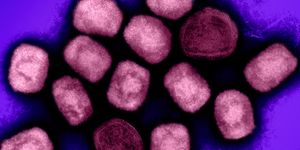Understanding Why TET2 Mutations Often Lead to Cancer & Disease
Scientists have now discovered why a mutation in a gene called TET2 is often implicated in disorders including diabetes, heart disease, stroke, inflammatory diseases, and certain types of cancer. This gene is related to others that act on DNA, and researchers have now revealed that TET2 affects RNA; TET2 modifies certain RNA molecules with chemical tags, affecting the packaging of DNA. So when TET2 is mutated, all sorts of problems can follow. The findings have been reported in Nature.
The expression of protein-coding genes has to be carefully controlled, and cells use a variety of ways to activate and deactivate gene expression. We know that methyl groups are sometimes added to DNA; these act as chemical modifications that help regulate gene activity.
In recent years, scientists have also shown that messenger RNA molecules that serve as intermediaries to genes and the proteins they encode for can also be modified with methyl groups. RNA methylation is increasingly recognized as an important regulator of gene expression in plants and animals.
In this study, the researchers showed that TET2 can control the frequency of an RNA modification called m5C. This modification recruits a molecule called MBD6, which affects how DNA is packaged. DNA packaging is essential to cells; the genome must physically fit inside of them. Packaged DNA and its accompanying proteins are known as chromatin. Various regions of DNA also have to be physically accessible as well so that genes can be properly expressed, so chromatin is closely linked to how genes are expressed.
TET2 also allows chromatin to be looser during development, when cells are rapidly changing and dividing. But in adults, TET2 is supposed to keep DNA under tighter control. If that doesn't happen, serious problems can arise. These findings can explain why TET2 mutations are so frequently linked to certain types of cancer and other diseases; they can have many downstream impacts on different genes.
"If you have a TET2 mutation, you reopen this growth pathway that could eventually lead to cancer, especially in the blood and brain, because this pathway looks to be most important in blood and brain development," explained senior study author and Howard Hughes Medical Institute investigator Chuan He, a Professor at the University of Chicago.
This study has also revealed potential new drug targets. "What we hope we can get from this is a silver bullet to selectively get rid of just cancer cells, by targeting this specific pathway activated because of TET2 or IDH loss," said He.
The work has major implications for the understanding of chromatin, and gene expression in general. Another type of RNA methylation called m6A is known to impact gene expression by affecting chromatin structure, but this study has shown that m5C can also influence gene expression through chromatin. Professor He suggested that there may be many more of these types of RNA modifications to chromatin that alter gene expression, and they are just waiting to be discovered.
"This represents a conceptual breakthrough," said He. "Not only does it offer targets for therapy for several diseases, but we are adding to the grand picture of chromatin regulation in biology. We hope the real-world impact is going to be very high."
Sources: University of Chicago, Nature









